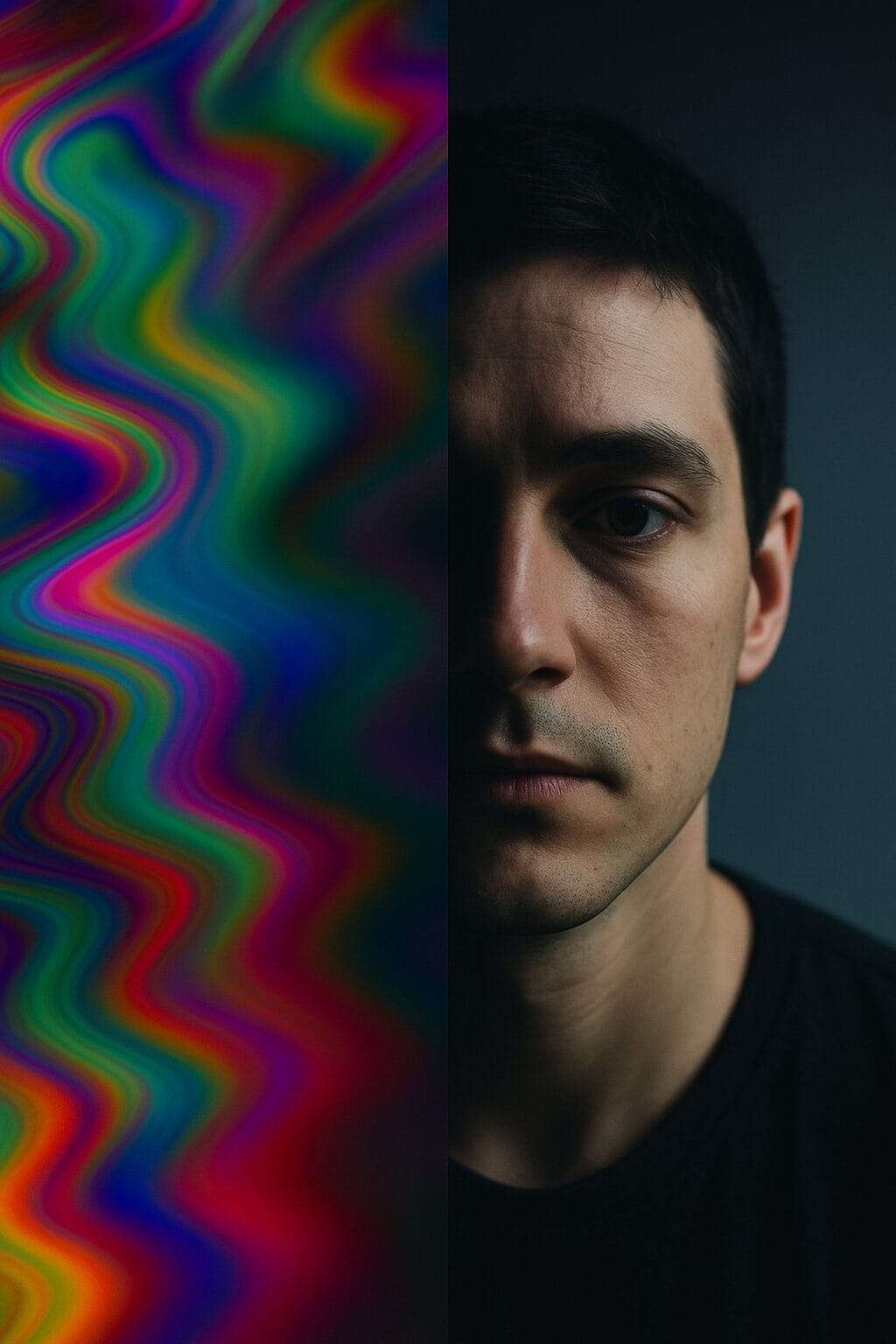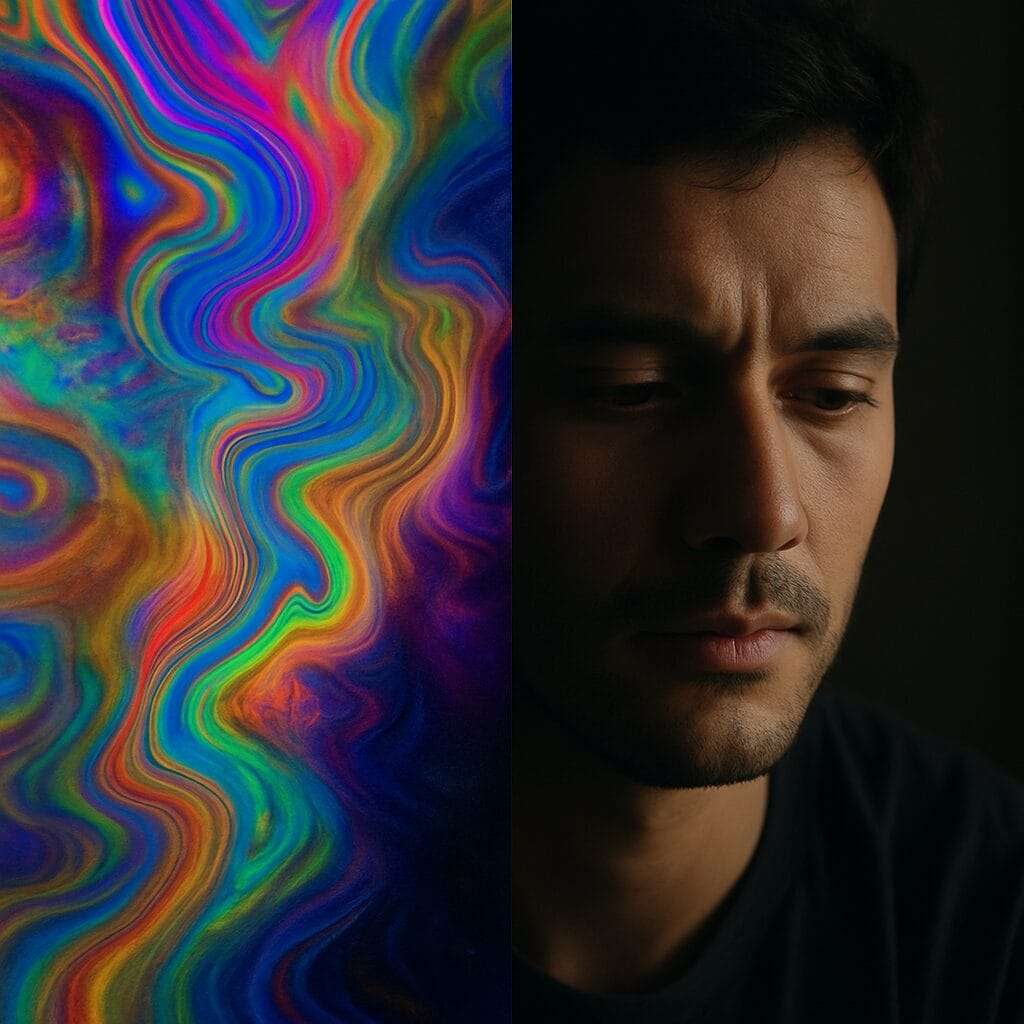
Psychedelic Therapy for Trauma: Healing, Hype, or Bypassing?
- Updated: June 9, 2025
You’ve heard the stories.
A tech exec flies to Peru. A celebrity “finds themselves” in the jungle. A friend of a friend comes back from a retreat saying they saw God—and also maybe quit their job, got divorced, or joined a spiritual startup.
Psychedelic therapy has officially gone mainstream.
But here’s the real question:
Do you really need to vomit in the Amazon to heal your trauma?
That’s the question more leaders, professionals, and high-functioning survivors are quietly wrestling with. The buzz around ayahuasca, psilocybin, and ketamine isn’t just about mental health anymore—it’s about meaning. About escape. About trying to shortcut the long, gritty work of integration by chasing one chemically-induced breakthrough.
I wrote this not to shame the method—but to unpack the myth. Because while psychedelics may open a door, they don’t teach you how to live in the house. And most people never hear the unsexy half of the story: the aftermath. The come-down. The emotional whiplash. The healing work that still waits once the vision fades.
So let’s get honest:
What’s actually happening in the brain during a psychedelic trip?
What’s the difference between insight and bypassing?
And why is long-term trauma healing still so essential—even if you’ve already “seen the light”?
If you’re feeling pressured to catch the next spiritual trend—or you’re just trying to sort real healing from high-gloss marketing—I made this for you. This isn’t a hype piece. Here’s what we’ll explore—honestly, and without shortcuts.
Let’s begin.
🧭 What We’ll Explore
💡 You Can’t Trip Your Way Out of Trauma
If you’re burned out, haunted by trauma, or tired of carrying emotional weight that no one else sees—of course you want relief. Of course you’re curious when you hear that one trip could unlock the clarity or peace you’ve been chasing for years.
But here’s the problem:
Breakthrough ≠ Integration.
Insight isn’t the same as healing.

A psychedelic trip might show you your pain—but it won’t teach you how to hold it. It might break open your truth—but it won’t help you rebuild what was broken. That’s where real trauma-informed support matters. Not as a buzzkill, but as a bridge. A stabilizer. A guide through the messy middle, not just the mystical high.
Because if the insight you gain while high disappears when you come down…
You didn’t heal—you dissociated more creatively.
What most people don’t realize is that emotional clarity doesn’t require you to purge in the jungle.
Sometimes it just requires slowing down, finding a safe space, and sitting with someone who knows how to help you metabolize what’s been trapped in your body for years.
If you’re considering psychedelics—or have already done them and feel more lost than enlightened—this is your invitation to pause. Not because you’re wrong for seeking relief, but because you deserve better than spiritual chaos disguised as healing.
⚠️ What Psychedelics Actually Do to Your Brain
Let’s cut through the buzzwords for a moment. If you’ve ever wondered how psychedelic therapy supposedly “works,” here’s what’s actually going on inside your brain during a trip:

🔬 The Science:
Psychedelic substances like LSD, psilocybin (magic mushrooms), MDMA (ecstasy), ketamine, and ayahuasca disrupt your brain’s usual operating system.
Specifically, they reduce activity in the amygdala—the brain’s fear center. That’s the part responsible for your fight-or-flight response. When it’s turned down, you’re more able to sit with intense memories or emotions without becoming overwhelmed.
At the same time, these substances increase cross-talk between disconnected areas of the brain, creating new temporary connections. That can result in profound feelings of insight, interconnectedness, even spiritual awakening.
This neurological soup is what creates that “magical” feeling: openness, softness, clarity, connection. And yes—it’s real. It’s measurable. But it’s also chemically induced. Which means…
You didn’t eliminate fear—you muted it. You didn’t rewire trauma—you bypassed the block, temporarily.
🧠 Why It Feels So Powerful:
For people who’ve spent years trapped in trauma responses—hypervigilance, emotional shutdown, or numbness—this sudden internal shift can feel like a miracle.
You finally feel.
You finally see.
You finally breathe without panic.
And that’s not nothing.
But here’s the catch:
That clarity? It fades.
That emotional openness? It collapses without structure.
That insight? It doesn’t mean a damn thing if you can’t integrate it back into your daily life.
⚠️ The Reality Check:
Almost every credible study on psychedelics and trauma emphasizes the same truth:
The drugs alone are not the healing.
The real work happens when you process the experience with a trained, trauma-informed therapist or coach. Otherwise, you’re just chasing moments—without anchoring meaning.
That’s why people can have life-altering revelations in the jungle… and then come home and feel more lost than before.
🧲 Why People Still Get Drawn In:
Let’s be honest—there are some seductive benefits that people report:
Fast relief from PTSD and depression
Temporary boosts in empathy and emotional connection
Fresh perspectives on painful memories
Reduced anxiety (for some)
Enhanced creativity and problem-solving (but again… don’t microdose your way through leadership)
And yes, some of this has scientific backing. But none of it is guaranteed. And none of it sticks without integration.

🧭 Why You Still Need a Guide—Even If You “Saw Everything” on Your Trip
Let’s be honest: psychedelic therapy is not a DIY project.
You might have read a story about someone microdosing their way out of depression. Or maybe you’ve seen a post-trip testimonial that sounds like a spiritual rebirth. But the reality is this:
Hallucinogenic therapy opens the door—but it doesn’t help you walk through it.
Without guidance, insight becomes noise. And noise doesn’t heal trauma—it just stirs it up.
Here’s why working with a trauma-informed professional still matters, even if you’ve already had a “life-changing” experience:

🔒 Safety
Not every brain is built to handle psychedelic disruption. People with certain conditions—like bipolar disorder, dissociative patterns, or unresolved complex trauma—may be at higher risk for post-trip destabilization. A skilled practitioner can assess this before you spiral.
⚖️ Dosing
Too little does nothing. Too much can fry your emotional circuits. Clinical settings use specific protocols for a reason—and your body, history, and tolerance all matter.
🧩 Integration
The trip might show you something. But the meaning comes after. A guide helps you sift through what was symbolic, what was sensory overload, and what actually deserves integration.
📜 Legal Boundaries
Many of these substances are still illegal in most of the U.S. Licensed professionals who do this work operate within highly specific frameworks. You deserve clarity—not a headline about your retreat ending in a legal mess.
💠 Containment & Repair
A trip can tear open a wound—but it can’t sit with you when the flashbacks return or your relationships start to unravel. That’s not a knock on the medicine—it’s a reminder that no substance, no matter how sacred, can replace human connection and professional care.
Bottom line: If you’ve cracked something open, you still need someone who knows how to hold it with you—gently, skillfully, and without agenda.
🧠 What Happens Neurologically During Psychedelic Breakthroughs
During a psychedelic trip—whether it’s ayahuasca, psilocybin, LSD, or ketamine—something fascinating happens in the brain:
The Default Mode Network (DMN)—the part responsible for ego, self-reflection, and time awareness—goes quiet. And when that happens:
The sense of “I” softens. This is why many people describe ego death or merging with a higher consciousness.
Brain regions that normally don’t communicate suddenly light up. This cross-talk creates vivid insights, emotional releases, and mystical visions.
Long-buried trauma or memories can surface—because the internal gatekeepers are offline.
It’s like jazz improv in your brain: fluid, creative, boundaryless—but also chaotic and ungrounded.

💥 Emotionally, here’s what that feels like:
Grief, rage, awe, and joy come rushing in—no buffer, no filter.
Old trauma can resurface without context, leaving people cracked open mid-trip.
Catharsis often masquerades as healing—but it’s usually exposure, not resolution.
That’s why so many people feel like they’ve healed something—when in reality, they’ve just opened the attic. The dust is still in the air.
🧩 What Integration Really Looks Like
Integration is what comes after the vision ends—and the real work begins.
It’s the process of:
Making meaning from what surfaced
Building behavioral pathways from insights
Learning how to sit with your truth without needing another emotional spike
And here’s why that matters:
Because vomiting in front of a shaman might feel like release—but release isn’t the same as repair.
You might come back with a spiritual insight, but if you don’t build a life that can hold it, you’ll either chase the next breakthrough… or collapse under the weight of the last one.
Integration is better—not because it’s easier, but because it actually sticks.
You don’t just see the pattern—you start responding differently when it shows up again.
You don’t need a ceremony to feel connected—you start building rituals of safety inside your daily life.
You don’t rely on peak moments to feel alive—you start living in a way that feels honest even on the ordinary days.
Psychedelics can flood you with insight.
But integration teaches you how to carry truth—without needing to be cracked open every time.

🧠 Neurologically:
This is neuroplasticity in motion.
You’re rewiring slowly, through:
Consistency
Safety
Relationship
Choice
You start responding to trauma with presence, not panic
You stay conscious—your Default Mode Network (DMN) is online, which means you’re integrating with awareness, not dissociating
You’re rebuilding, not reliving
It’s slower. It’s messier. But it sticks.
❤️🩹 Emotionally:
- You develop tolerance for discomfort
- You build emotional scaffolding—the inner capacity to revisit grief or trauma without collapse
- You start recognizing the unglamorous victories:
Grieving a memory without turning it into a performance
🔄 In Summary:
| Psychedelic Breakthrough | Long-Term Integration | |
|---|---|---|
| Speed | Instant, intense | Slow, layered |
| Access | Gate-crashing the subconscious | Building bridges over time |
| Feeling | Euphoric, overwhelming | Grounded, gritty |
| Stability | Short-lived unless supported | Lasting, self-sourced |
| Risk | Re-traumatization, delusion | Emotional fatigue, but clarity |
| Reward | Flash of truth | Embodied transformation |
❓Common Questions About Psychedelics and Healing
❓ Are you saying psychedelics don’t work?
No—I’m saying they don’t work alone. Psychedelic experiences can be powerful, even sacred. But insight without integration isn’t healing—it’s just exposure.
❓ What if I already did a trip and now I feel worse?
That doesn’t mean you failed. It means your body and nervous system may still be processing what got stirred up. That’s where trauma-informed support becomes essential—not to fix you, but to help you metabolize what surfaced.
❓ Do I need to take psychedelics to access deep healing?
Absolutely not. Many people experience profound healing through somatic work, relational repair, and sustained emotional sobriety—without ever taking a substance. Psychedelics are one doorway. Not the only one.
❓ Can I integrate on my own?
You can begin. But most people—especially those with complex trauma—need reflection, containment, and co-regulation. Integration isn’t just intellectual. It’s relational. You weren’t wounded alone. You shouldn’t have to heal alone, either.
💬 Final Thoughts: Healing Doesn’t Require Collapse to Be Real
Psychedelics may open a door, but it’s your everyday choices—your emotional sobriety, your capacity to stay present with discomfort, your willingness to integrate—that actually rebuild your life.
Healing isn’t about chasing a high.
It’s about learning how to stay grounded when the dust settles.
No ceremony, no shaman, no shortcut will do that for you.
But you can.
And you don’t have to do it alone.
Ready to Dig Deeper?
💛 Ready to do the slow, grounded work that actually sticks?
I’d be honored to walk with you.
👉 Apply for coaching – I work with leaders and deep-feelers who are ready to untangle the real roots, not just manage symptoms.
📬 Want more emotionally sober insights like this in your inbox?
My newsletter cuts through the noise with grounded truth, healing psychology, and leadership clarity.
Got thoughts or questions about this article?
I’d love to hear from you.
👉 Write me a note





